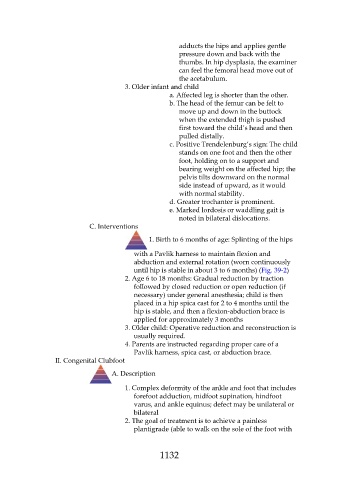Page 1132 - Saunders Comprehensive Review For NCLEX-RN
P. 1132
adducts the hips and applies gentle
pressure down and back with the
thumbs. In hip dysplasia, the examiner
can feel the femoral head move out of
the acetabulum.
3. Older infant and child
a. Affected leg is shorter than the other.
b. The head of the femur can be felt to
move up and down in the buttock
when the extended thigh is pushed
first toward the child’s head and then
pulled distally.
c. Positive Trendelenburg’s sign: The child
stands on one foot and then the other
foot, holding on to a support and
bearing weight on the affected hip; the
pelvis tilts downward on the normal
side instead of upward, as it would
with normal stability.
d. Greater trochanter is prominent.
e. Marked lordosis or waddling gait is
noted in bilateral dislocations.
C. Interventions
1. Birth to 6 months of age: Splinting of the hips
with a Pavlik harness to maintain flexion and
abduction and external rotation (worn continuously
until hip is stable in about 3 to 6 months) (Fig. 39-2)
2. Age 6 to 18 months: Gradual reduction by traction
followed by closed reduction or open reduction (if
necessary) under general anesthesia; child is then
placed in a hip spica cast for 2 to 4 months until the
hip is stable, and then a flexion-abduction brace is
applied for approximately 3 months
3. Older child: Operative reduction and reconstruction is
usually required.
4. Parents are instructed regarding proper care of a
Pavlik harness, spica cast, or abduction brace.
II. Congenital Clubfoot
A. Description
1. Complex deformity of the ankle and foot that includes
forefoot adduction, midfoot supination, hindfoot
varus, and ankle equinus; defect may be unilateral or
bilateral
2. The goal of treatment is to achieve a painless
plantigrade (able to walk on the sole of the foot with
1132

